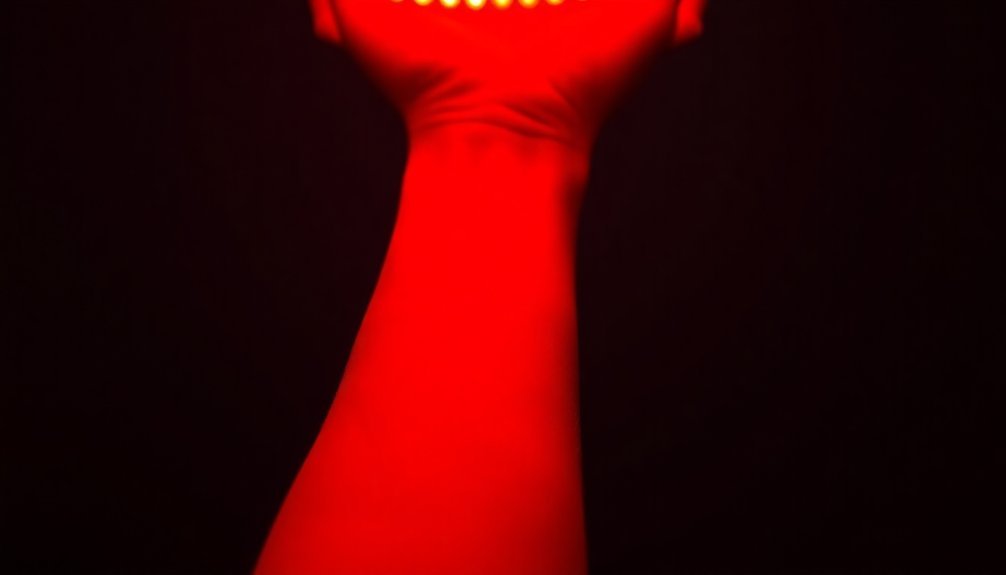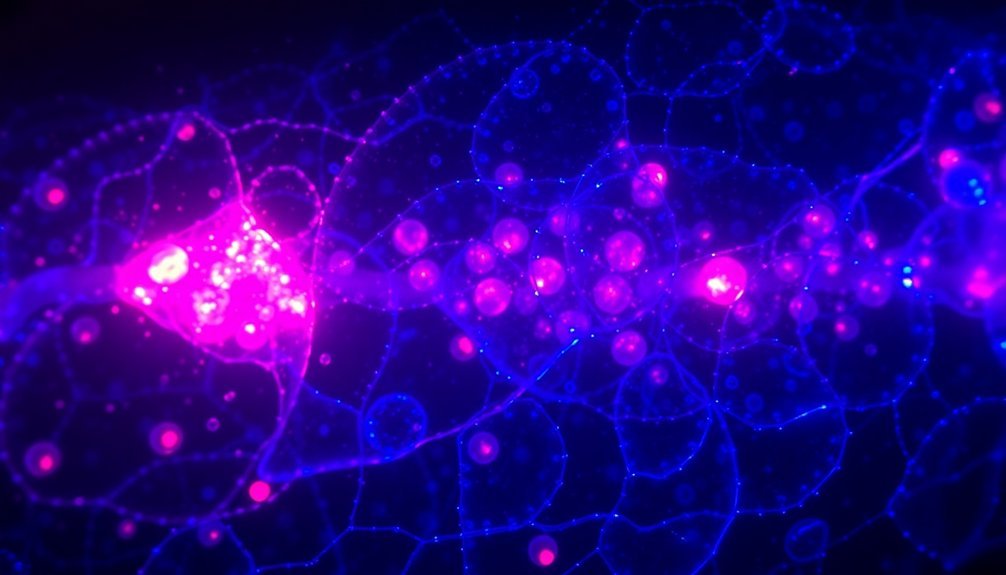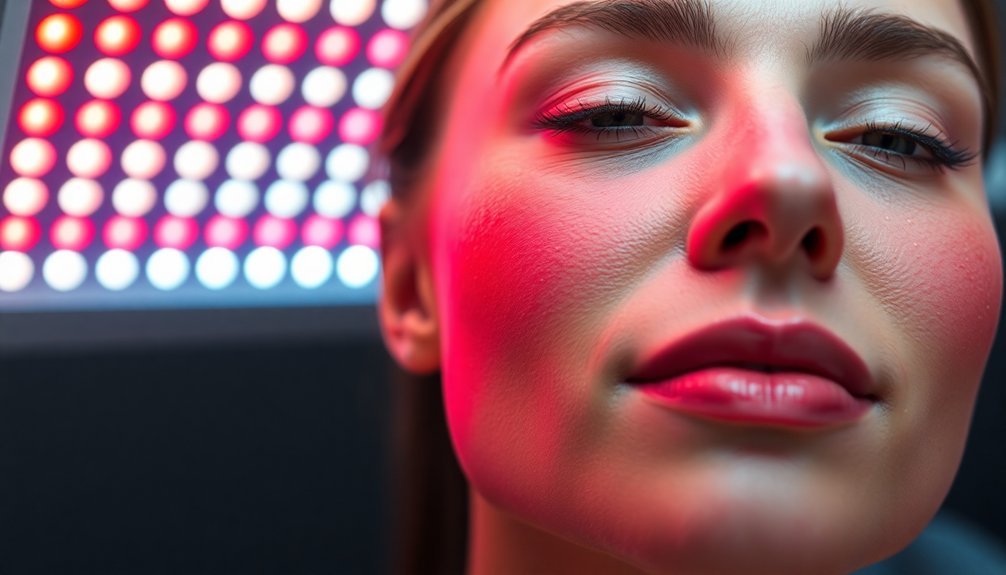Light therapy calms your irritated, inflamed skin quickly by triggering powerful healing responses at the cellular level. When specific red and near-infrared wavelengths penetrate your skin, they boost your cells' energy production and activate natural repair mechanisms. This process reduces inflammation by up to 70% while modulating your immune response and restoring proper cytokine levels. Your skin's fibroblasts respond by increasing collagen production, which helps repair damaged tissue and strengthen the skin barrier. The treatment's non-invasive nature and proven effectiveness make it an excellent option for various skin conditions, with countless studies revealing its deeper therapeutic benefits.
Understanding Red Light Therapy Basics

If you're struggling with inflamed skin, red light therapy offers a promising solution that's gaining attention in skincare circles. This innovative treatment uses specific wavelengths of red and near-infrared light that penetrate deep into your skin's layers, triggering natural healing responses within your cells.
You'll find that red light therapy works by targeting your skin's cellular energy centers, known as mitochondria. When these light waves reach your cells, they boost ATP production – your body's cellular energy currency – which enhances your skin's ability to repair and rejuvenate itself. The therapy can reduce muscle fatigue and support faster recovery.
The therapy stimulates your lymphatic system, improving waste removal and supporting proper immune function.
What makes this treatment particularly appealing is its non-invasive nature and broad range of benefits. You're not just addressing surface-level inflammation; you're activating deeper healing processes. The therapy triggers collagen production, which helps maintain your skin's elasticity and strength.
While it's generally safe to use, you'll need to follow proper guidelines to avoid potential side effects like burns or eye damage. For ideal results, you can combine red light therapy with anti-inflammatory dietary choices and a healthy lifestyle.
Science Behind Skin Inflammation
Your skin's inflammatory response kicks in when your immune system detects threats like infections, allergens, or physical trauma, triggering a complex cascade of cellular signals.
During inflammation, your body releases specialized proteins that activate immune cells and increase blood flow to the affected area, leading to familiar symptoms like redness, warmth, and swelling.
These inflammatory signals work through specific pathways, such as the IL-17 and HIF-1-alpha pathways, which control how your skin cells communicate and respond to inflammation triggers. Recent research shows that metabolic changes occur in inflamed skin cells, contributing to ongoing inflammation.
Inflammatory Response Basics
The inflammatory response is your body's natural defense mechanism against injury, infection, and harmful substances. When your skin encounters a trigger – whether it's a bacterial infection, allergen, or injury – your immune system launches a complex series of protective actions.
Your body begins this process with a brief narrowing of blood vessels, followed by rapid dilation to increase blood flow to the affected area. You'll notice classic signs of inflammation: redness, warmth, swelling, and pain. These symptoms occur because chemicals like prostaglandins and histamine make your blood vessels more permeable, allowing fluids and proteins to move into the damaged tissue. When inflammation occurs, many people experience itching and burning sensations that can range from mild to severe.
There are two main types of inflammation you might experience. Acute inflammation is a short-term response that helps initiate healing, while chronic inflammation can persist for months or years.
During either type, your immune cells, particularly neutrophils, travel to the affected site to fight off potential pathogens. You may develop visible symptoms like rashes, which can be smooth or scaly, and in some cases, your skin might become thickened or develop blisters that can crack and bleed.
Cell Communication During Inflammation
Skin's complex inflammatory response relies on an intricate network of cellular communication pathways. When your skin encounters stress or irritation, keratinocytes immediately spring into action, releasing specific alarm signals called alarmins and cytokines that alert nearby immune cells and sensory neurons.
Your skin's dendritic cells play an essential role by responding to signals like IL-12 and IL-23 through STAT4 pathways, initiating the inflammatory cascade. They'll communicate with other immune cells, coordinating your body's defense response. The photon absorption by cells during red light therapy helps optimize this immune coordination process.
Meanwhile, your sensory neurons aren't just passive observers – they actively participate by releasing neuropeptides that directly influence immune cell behavior.
The communication network extends to specific inflammatory mediators like IL-33 and TSLP, which activate your sensory neurons to trigger itch responses and type 2 immune reactions. IL-4 and IL-13 further amplify this response by driving barrier inflammation.
Your endothelial cells join the conversation by facilitating immune cell migration from blood vessels into affected skin areas. This orchestrated cellular communication explains why red light therapy's ability to modulate cytokine production and enhance cellular energy can effectively calm inflammation.
Cellular Response to Light Treatment

Red light therapy springs your skin cells into action, triggering an immediate recovery response that helps calm inflammation and repair damaged tissue.
When light hits your skin cells, chromophores absorb photons and initiate healing processes throughout the tissue layers.
You'll notice your skin's repair mechanisms kick into high gear as the light penetrates deep into the tissue, stimulating the production of cellular energy and activating protective pathways.
The treatment boosts your natural collagen production while enhancing blood flow, which works together to speed up healing and strengthen your skin's resilience.
Immediate Cell Recovery Activation
Light therapy's impact on cellular recovery occurs through up to four distinct mechanisms, triggering an immediate cascade of healing responses within damaged tissue.
When you receive light therapy treatment, your cells activate TGF-β1, an essential protein that stimulates fibroblasts and macrophages to begin the repair process.
Your cellular mitochondria respond to red and near-infrared light by increasing energy production, which directly fuels tissue repair.
This boost in cellular energy leads to enhanced collagen production and reduced oxidative stress, while simultaneously promoting anti-inflammatory protein production and improved blood flow to the affected areas.
Treatment with red light therapy showed superior results, reducing healing time to just 42 days compared to other methods.
You'll experience accelerated healing as your body responds to the treatment, with studies showing up to 50% faster wound recovery compared to untreated areas.
The light therapy stimulates your epithelial growth and activates growth factors vital for tissue regeneration.
It's a non-invasive process that's particularly effective at calming inflammation and reducing pain through enhanced cellular metabolism.
The treatment's ability to penetrate different skin layers means you're getting both surface-level benefits and deeper tissue repair, making it especially effective for managing various types of skin inflammation and damage.
Collagen Production Boost
Every aspect of collagen production accelerates when your skin cells receive targeted light therapy treatment. As red and near-infrared light penetrates your skin, it activates your fibroblasts – the vital cells responsible for creating collagen and elastin. This activation triggers a cascade of cellular responses that'll help calm your inflamed skin while rebuilding its structure.
You'll notice improvements in your skin's texture and firmness as the light therapy stimulates your cells' mitochondria, boosting their energy production. The treatment typically requires multiple sessions for optimal results. This enhanced cellular energy directly supports collagen synthesis, which is essential for maintaining your skin's elasticity and reducing the appearance of fine lines.
What's more, the therapy's anti-inflammatory effects create an ideal environment for continued collagen production.
Clinical studies have confirmed that you'll get both immediate and long-term benefits from this non-invasive treatment. Whether you're using a professional device at a clinic or a home treatment system, you're tapping into your skin's natural ability to produce collagen.
The therapy works particularly well when your skin is inflamed, as it simultaneously reduces inflammation while supporting your tissue's natural repair processes through enhanced collagen production.
Red Light's Healing Mechanisms
Through advanced research in phototherapy, scientists have uncovered how red light therapy works to heal inflamed skin at the cellular level. When red light penetrates your skin, it triggers a cascade of healing mechanisms that target inflammation and cellular repair. Your skin cells' mitochondria absorb this light, boosting ATP production – your cells' energy source – which accelerates healing and reduces inflammatory responses. The therapy's non-invasive nature makes it a safe and gentle option for most skin types.
| Healing Mechanism | Direct Benefits |
|---|---|
| ATP Production | Increases cellular energy and repair speed |
| Fibroblast Activation | Boosts collagen and elastin production |
| Anti-inflammatory Response | Reduces IL-6 and TNF-α cytokine levels |
You'll experience faster healing because red light therapy stimulates your skin's natural repair processes. It energizes fibroblasts, which produce collagen and elastin, while simultaneously calming inflammation through regulated immune responses. The therapy's effectiveness comes from its ability to restore proper cytokine levels and activate Langerhans cells, which help moderate your immune system's response to irritation.
While red light therapy is generally safe, you'll need to follow proper treatment guidelines to avoid potential side effects from overexposure. Studies show it can reduce inflammation and pain by up to 70%, making it a powerful tool for skin healing.
Treating Common Skin Conditions

When it comes to managing various skin conditions, phototherapy has emerged as a versatile treatment option that targets multiple dermatological concerns.
If you're struggling with psoriasis, you'll find that narrowband UVB and PUVA therapy can effectively regulate abnormal cell growth and reduce inflammation, though it's essential to acknowledge that PUVA may increase skin aging risks.
For eczema and atopic dermatitis that haven't responded to topical treatments, light therapy offers precise, localized treatment that controls inflammation and relieves itching.
You'll notice improvements in both small affected areas and widespread symptoms.
If you're dealing with acne, red light therapy provides a safe solution with minimal side effects. It works by reducing inflammation, decreasing sebum production, and fighting acne-causing bacteria, leading to clearer skin.
Light therapy isn't limited to these conditions – it's also effective for vitiligo, scleroderma, and even certain skin cancers like cutaneous T-cell lymphoma.
The treatment's ability to modulate inflammatory responses makes it valuable for various skin disorders, offering you a non-invasive option that can greatly improve your skin's health.
Clinical Benefits for Skin Health
Inside clinical settings, LED light therapy delivers powerful benefits for skin health through multiple healing mechanisms. When you receive red or near-infrared light therapy, it immediately begins reducing inflammation by targeting reactive oxygen species and prostaglandins.
The treatment also boosts your skin cells' energy production through enhanced ATP creation, allowing them to repair damage more effectively. You'll experience improved circulation as the light penetrates your tissue, which helps deliver essential nutrients and oxygen to skin cells.
The therapy stimulates your fibroblasts, leading to increased collagen production – crucial for maintaining firm, youthful skin and proper wound healing. If you're dealing with acne, blue light specifically targets the bacteria causing breakouts while reducing inflammation.
For inflammatory conditions like psoriasis, the combination of red and near-infrared light can markedly reduce symptoms. The treatment's versatility extends to addressing multiple concerns simultaneously – you can target signs of aging while improving overall skin texture and reducing inflammation.
Since it's safe for all skin types and carries minimal risk of side effects, you can receive treatments regularly under professional supervision for best results.
Treatment Duration and Frequency

Different types of light therapy treatments call for varying durations and frequencies to achieve ideal results. You'll find that UVB therapy typically starts with brief sessions under 5 minutes, gradually increasing to 30 minutes over time, with treatments scheduled 2-3 times weekly for 12-16 weeks.
| Treatment Type | Duration | Frequency | Course Length |
|---|---|---|---|
| UVB Light | 5-30 minutes | 2-3x weekly | 12-16 weeks |
| UVA1 Light | Variable | 5x weekly | 3-4 weeks |
| PUVA | Variable | 2x weekly | 12-16 weeks |
| LED/Red Light | 10-30 minutes | 3-5x weekly | Ongoing |
If you're receiving UVA1 therapy, you'll need to commit to five sessions per week for 3-4 weeks, while PUVA treatment requires twice-weekly sessions over 12-16 weeks. LED and red light therapy offer more flexibility, with sessions lasting 10-30 minutes and recommended frequency of 3-5 times per week. You'll need to maintain consistency with your chosen treatment schedule, as regular attendance is essential for ideal results. Your healthcare provider will adjust your treatment duration and frequency based on your skin condition, tolerance, and response to therapy.
Combining Therapies for Better Results
Maximizing your light therapy results often involves combining it with complementary treatments. When you pair LED light therapy with chemical peels or microneedling, you'll enhance the absorption of active ingredients while promoting faster healing. The combination can considerably reduce inflammation and accelerate your skin's recovery process.
Red light therapy works particularly well with facial treatments and skincare products, boosting their effectiveness through improved absorption. You'll find that blue light targets acne-causing bacteria while yellow light calms redness and irritation, making these combinations especially effective for specific skin concerns like rosacea or acne.
What's particularly beneficial is that LED light therapy is safe to combine with virtually any treatment. You won't increase your risk of adverse effects, and it's suitable for all skin types and tones.
When you're dealing with chronic conditions like eczema or psoriasis, combining red light therapy with your existing treatments can enhance healing and reduce inflammation. For anti-aging purposes, you'll see better results when you pair LED therapy with collagen-stimulating treatments, as they work synergistically to improve skin texture and reduce signs of aging.
Frequently Asked Questions
Can Red Light Therapy Make Existing Skin Conditions Temporarily Worse?
Yes, you may experience temporary worsening of your skin conditions during initial red light therapy treatments. Your skin could become itchy and red, but these effects typically subside as your skin adapts to treatment.
How Long Does Skin Stay Calm After Completing a Treatment Session?
You'll notice immediate calming effects with LED therapy that can last several hours. With UVB phototherapy, your skin's calmness builds over the treatment course and may last months after completing your sessions.
Is It Safe to Wear Makeup During Red Light Therapy Sessions?
You'll get better results if you don't wear makeup during red light therapy. While it's technically possible with high-power equipment, makeup can block light penetration and reduce benefits. It's best to start with clean skin.
Does Skin Type or Color Affect the Effectiveness of Light Treatment?
No, your skin type or color won't affect light therapy's effectiveness. Research shows it works equally well for all skin tones, though you'll need proper dosing adjustments based on your specific skin type.
Can Red Light Therapy Prevent Future Inflammatory Skin Conditions From Developing?
Yes, you'll find red light therapy can help prevent future skin inflammation by promoting cellular repair, enhancing blood flow, and strengthening your skin's natural defenses. Regular treatments support long-term skin health.
In Summary
You'll find light therapy offers a powerful, non-invasive way to calm your irritated skin and reduce inflammation quickly. When you combine red light treatments with your existing skincare routine, you're giving your cells the boost they need to repair and regenerate. For best results, stick to consistent sessions and follow recommended treatment times. Your skin's natural healing response will thank you with a calmer, healthier appearance.





Leave a Reply